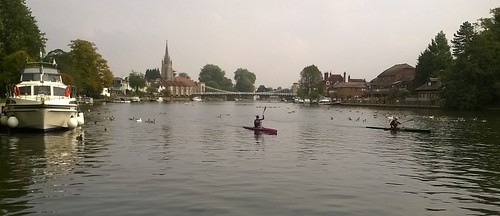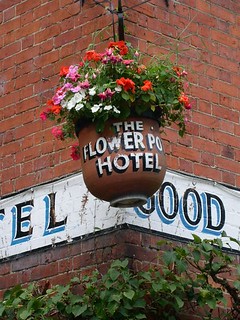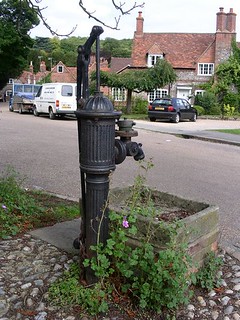Marlow Circular walk
The Thames path in the morning, a classic pub for lunch, gentle hill afterwards.

Not quite still life in Marlow
Thames
Oct-15 • magyardave2002 on Flickr
swcwalks book2 walk8 banner 21964261712






| Bridge Closed | [2024-06] Temple Footbridge across the Thames, about 3 miles from the start is closed. Repairs or replacement will take some time. See below. |
|---|---|
| Length |
Main walk: 21.3km (13.2 miles) With alternative ending: 23.6km (14.7 miles) Marlow to Henley: 13.5km (8.4 miles) or 15.2km (9.4 miles) |
| Maps | OS Landranger Map No 175. OS Explorer Map 172 and 171 |
| Toughness | 4 out of 10 |
| Features |
The morning route of this walk is currently blocked three miles west of Marlow, due to the prolonged closure of the footbridge over the Thames near Temple Lock. See Comments for this walk. Until this is resolved, the morning of the walk is not passable. A map-led alternative along the north bank of the Thames is suggested below. For an alternative walk of similar character, follow #cw1.1 Henley Circular via Great Wood or #cw2.7 Henley via Hambleden Circular walks on this site as far as lunch in Hambleden, and then do the afternoon of this walk into Marlow. The official Thames Path diversion along the south bank from Marlow via Bisham is not recommended (long busy road, then narrow lane with no pavement) If all you know of the Thames is the grey muddy stretch that runs through London, on this walk you are in for a pleasant surprise. The Thames above Marlow is a lazy, tranquil river, which runs between pleasant meadows and overhanging trees, occasionally overlooked by fine old manor houses. The area is also known as a habitat for red kites - look up to see them hovering overhead. This walk follows the Thames Path for the first 8km (5 miles), passing the ancient village of Hurley, little changed since the days when it was a Benedictine monastery. Lunch is in Aston or Hambleden, both quaint riverside villages. By contrast, the afternoon takes you up over the wooded hills (passing through Homefield Wood, which in July is a prime spot for the silver-washed fritillary butterfly), and then back down into the well-preserved Georgian town of Marlow for tea. |
| Walk Options |
- Alternative ending: This route into Marlow goes down a pleasant valley and then on tracks between fields into the centre of the town. It avoids road walking but is 2.3km (1.4 miles) longer, making a total walk of 23.9km (14.8 miles). - Marlow to Henley: There are two ways to end this walk in Henley. i) From the Flower Pot in Aston you can carry on over Remenham Hill, making a total walk of 13.5km (8.4 miles) or ii) from Hambledon Lock you can carry on along the Thames path, making a total walk of 15.2km (9.4 miles). - North bank route: With a 1:25K OS Map, instead of crossing the river on the Temple footbridge, you can stay on the north bank all the way to Hambledon Lock, to pick up the route there. This scenic route (roughly) follows the river via Low Grounds Farm, East Lodge, Harleyford Golf Club, Medmenham (Dog and Badger pub), the towing path to Hambledon Place, to Mill End / Hambledon Lock to rejoin the route. This diversion is about 1/3 of the entire walk. - Number 800 buses between Henley and Marlow stop on the main road just beyond Hambleden Lock, making it possible to end the walk here after 11.2km (7 miles). There are up to three buses an hour during peak hours Monday to Friday and two an hour on Saturdays, with buses every 40 minutes or so in the evenings. There is one bus an hour on Sundays until around 9pm. |
| Transport |
Trains run hourly between Paddington and Marlow, changing at Maidenhead (journey time: about 1 hour). Once on the branch line don’t be alarmed when the train reverses direction at Bourne End, which is quite normal. Catch the train nearest to 9am from Paddington to get to all the lunch pubs in time, though for lunch at the Flower Pot in Aston the train nearest to 10am is sufficient. If finishing in Henley, trains back are twice an hour, changing at Twyford. Buy a day return to Henley-on-Thames (not "in-Arden"), as this is the furthest station. This should also be accepted on the outward route to Marlow, but if not, you would only have to pay an excess from Maidenhead to Marlow. There is also a "Thames Branches Day Ranger" that covers both Henley and Marlow, but it is priced the same as a Henley return and is probably only obtainable from the ticket office (not the machines) at Paddington. |
| Lunch |
Hurley Lock, 4.2km (2.6 miles) into the walk, has a tea kiosk which is open from 10am-4pm Wednesday to Sunday and bank holidays from early April to late September. The Rising Sun, Hurley (01628 825733) is a possible early lunch stop, 4.9km (3 miles) into the walk. It is open all afternoon for drinks and food daily, apart from Mondays. The Olde Bell Inn nearby is more of a fine dining restaurant. The Flower Pot Hotel in Aston (01491 574721), 9.8km (6.1 miles) into the walk, has now reopened as a thoroughly modernised pub, but still with the same very pleasant garden. Food is served 12-3pm and 6-9pm Tuesday to Saturday, though with a bar menu available all afternoon, and from 12-5pm on Sundays. The pub is open all afternoon and evening for drinks (to 7.30pm on Sunday). Closed Monday, apart from bank holidays, when Sunday hours apply. The Stag and Huntsman in Hambleden (01491 571227), 12.9km (8 miles) into the walk, is is a cosy, atmospheric old pub with a reasonably large garden. It serves food from 12-3pm and 6-9pm on weekdays and all day on Saturday and Sunday, and is open all afternoon daily for drinks. Hambleden Village Stores: Located 12.8km (7.9 miles) into the walk, this superior village shop has few outside tables and serves tea, coffee, homemade cakes and delicatessen items (sometimes even soup), making it a possible light lunch or early tea stop. It is open to 5pm Monday to Saturday and 4pm on Sunday. Hambleden church also sometimes sells tea and cakes on summer Sundays. Almost anywhere in the first five miles of the walk would be an ideal place for a picnic. Marlow High Street (passed early in the walk) is the obvious place to buy picnic items: if you forget, the Hurley Village Shop can help you out. It is open 8am to 2pm daily. |
| Tea |
There is no shortage of cafés in Marlow High Street, some of them staying open till 6pm or 7pm, but they tend to change names quite often. A reliable old favourite is Burgers on the left at the bottom of the High Street, just before the church. Despite its name, this is an upmarket patisserie and tea room, open till 5pm Monday to Saturday (closed Sunday). Just beyond Burgers, the George & Dragon Inn is a modernised but very comfortable pub, which has big sofas and serves Costa Coffee hot drinks and cakes well into the evening. If finishing in Henley: The Chocolate Cafe (01491 411412) on the waterfront by the bridge is the recommended tea option, open from 9am-5.30pm Mon-Thurs, to 6pm Fri-Sun. The nearby Angel on the Bridge is one of many pleasant Henley pubs. |
| History |
Most of the fine buildings in Marlow's High Street and West Street are Georgian (18th century), but the town was already well established in the days of the Doomsday book (1085), when it had "twenty three copy-holders, one serf and one mill", as well as "a fishery which yields 1000 eels". Its church was famously surrounded by marsh, prompting one churchwarden in 1777 to ask for money "for a cast iron brazier wherein to make a large charcoal fire and warm the church in cold damp weather". Famous residents include Mary Shelley, who lived in West Street for a year along with her poet husband Percy Bysshe Shelley while finishing her novel Frankinstein. TS Eliot also came to Marlow to escape the bombing in London at the end of the First World War, and the town was home to Jerome K Jerome, whose novel Three Men in a Boat so immortalised the pleasures of "messing about on the river". Bisham Abbey (pronounced Biss'am), seen across the river on this walk, was given by Henry VIII to his divorced wife, Anne of Cleeves. Enticed by a flattering portrait by Holbein, Henry found he was not attracted to Anne when he actually met her. The marriage was never consumated and only lasted seven months. In return for swallowing the humiliation of the king's rejection and agreeing to an annulment, Anne got a generous financial settlement, including several fine estates (one of which was Hever, the childhood home of Anne Boleyn). She lived out the remaining 17 years of her life in comfort and honour. Henry became good friends with her and she was known as “The King's beloved sister”, with precedence over all woman in England save his own wife and daughters. She is the only one of Henry's wives to be buried in Westminister Abbey. The islands on which Hurley Lock is situated are one of the few places where the Thames splits into channels. A ford across the river at this point was the origin of Hurley, which is mentioned as far back as the Saxon Chronicles. Since the islands and the weirs erected between them were barriers to navigation, the villagers not surprisingly made a good living helping boats through them. The village of Hurley was once a Benedictine Monastery, and you can still get a real feel for what it must have been like in those days if you wander around it. The chapel of the monastery (now the Parish Church of St Mary The Virgin), its refectory and several other buildings are still extant. A leaflet is on sale just inside the church which gives a guided tour. Hambleden - not to be confused with Hambledon in Hampshire where cricket was invented - was the home of WH Smith, founder of the newsagents and stationery chain, who is buried in the churchyard. His widow became Vicountess Hambleden and the family still own the manor house. Smith became First Lord of the Admiralty after ten years as an MP, and as such was the assumed target of the song Ruler of the Queen's Navy in Gilbert and Sullivan's comic operetta HMS Pinafore, in which an obedient MP rises to that post without any nautical experience. Gilbert denied this, probably to avoid libel suits, but Smith was still known as Pinafore Smith in his lifetime, even being called this by the prime minister who had appointed him, Benjamin Disraeli. Towards the end of his life Smith also became Warden of the Cinque Ports and after six months in that role died in Walmer Castle, the warden's official home. Hambleden parish church has several interesting memorials, including one to the family of Sir Cope D'Oyley, who died in 1633, on which the children are shown carrying skulls if they died before their parents. To the left of this tomb is an oak chest used by the Earl of Cardigan when he led the ill-fated Charge of the Light Brigade in 1854. The parish church has several interesting memorials, including one to the family of Sir Cope D'Oyley, who died in 1633, on which the children are shown carrying skulls if they died before their parents. To the left of this tomb is an oak chest used by the Earl of Cardigan when he led the ill-fated Charge of the Light Brigade in 1854 Marlow station was originally just across the road from the pub, which in those days was known as the Station Hotel. In 1967 the station was moved to its current location, and a year later its former buildings were demolished. As its sign illustrates, the pub gets its name from the type of locomotive that used to work the short branch line from here to Bourne End - a "donkey" was a shunting engine normally used for moving wagons in the docks. At Bourne End the line met the Maidenhead to High Wycombe line, which was closed north of Bourne End in 1970. This is why the train now has to reverse direction there. |
| Book |
This walk was originally published in Time Out Country Walks near London volume 2. We now recommend using this online version as the book is dated. |
|---|---|
| Profile | |
| Help Us! |
After the walk, please leave a comment, it really helps. Thanks! You can also upload photos to the SWC Group on Flickr (upload your photos) and videos to Youtube. This walk's tags are: |
| By Train |
Out (not a train station) Back (not a train station) |
| By Car |
Start SL7 1NT Map Directions |
| Amazon | |
| Help |
National Rail: 03457 48 49 50 • Traveline (bus times): 0871 200 22 33 (12p/min) • TFL (London) : 0343 222 1234 |
| Version |
Apr-24 Peter |
| Copyright | © Saturday Walkers Club. All Rights Reserved. No commercial use. No copying. No derivatives. Free with attribution for one time non-commercial use only. www.walkingclub.org.uk/site/license.shtml |
Walk Directions
Full directions for this walk are in a PDF file (link above) which you can print, or download on to a Kindle, tablet, or smartphone.
This is just the introduction. This walk's detailed directions are in a PDF available from wwww.walkingclub.org.uk

